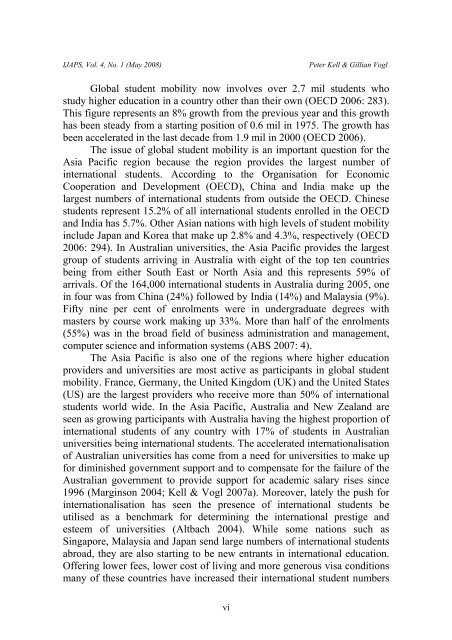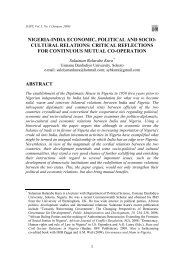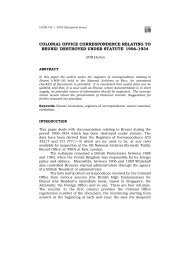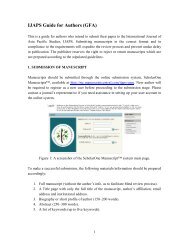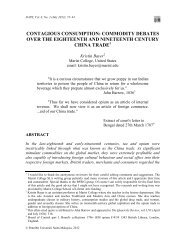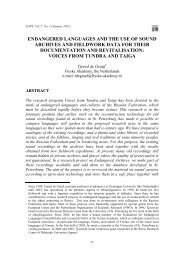This edition of the International Journal of Asia Pacific Studies ...
This edition of the International Journal of Asia Pacific Studies ...
This edition of the International Journal of Asia Pacific Studies ...
You also want an ePaper? Increase the reach of your titles
YUMPU automatically turns print PDFs into web optimized ePapers that Google loves.
IJAPS, Vol. 4, No. 1 (May 2008)Peter Kell & Gillian VoglGlobal student mobility now involves over 2.7 mil students whostudy higher education in a country o<strong>the</strong>r than <strong>the</strong>ir own (OECD 2006: 283).<strong>This</strong> figure represents an 8% growth from <strong>the</strong> previous year and this growthhas been steady from a starting position <strong>of</strong> 0.6 mil in 1975. The growth hasbeen accelerated in <strong>the</strong> last decade from 1.9 mil in 2000 (OECD 2006).The issue <strong>of</strong> global student mobility is an important question for <strong>the</strong><strong>Asia</strong> <strong>Pacific</strong> region because <strong>the</strong> region provides <strong>the</strong> largest number <strong>of</strong>international students. According to <strong>the</strong> Organisation for EconomicCooperation and Development (OECD), China and India make up <strong>the</strong>largest numbers <strong>of</strong> international students from outside <strong>the</strong> OECD. Chinesestudents represent 15.2% <strong>of</strong> all international students enrolled in <strong>the</strong> OECDand India has 5.7%. O<strong>the</strong>r <strong>Asia</strong>n nations with high levels <strong>of</strong> student mobilityinclude Japan and Korea that make up 2.8% and 4.3%, respectively (OECD2006: 294). In Australian universities, <strong>the</strong> <strong>Asia</strong> <strong>Pacific</strong> provides <strong>the</strong> largestgroup <strong>of</strong> students arriving in Australia with eight <strong>of</strong> <strong>the</strong> top ten countriesbeing from ei<strong>the</strong>r South East or North <strong>Asia</strong> and this represents 59% <strong>of</strong>arrivals. Of <strong>the</strong> 164,000 international students in Australia during 2005, onein four was from China (24%) followed by India (14%) and Malaysia (9%).Fifty nine per cent <strong>of</strong> enrolments were in undergraduate degrees withmasters by course work making up 33%. More than half <strong>of</strong> <strong>the</strong> enrolments(55%) was in <strong>the</strong> broad field <strong>of</strong> business administration and management,computer science and information systems (ABS 2007: 4).The <strong>Asia</strong> <strong>Pacific</strong> is also one <strong>of</strong> <strong>the</strong> regions where higher educationproviders and universities are most active as participants in global studentmobility. France, Germany, <strong>the</strong> United Kingdom (UK) and <strong>the</strong> United States(US) are <strong>the</strong> largest providers who receive more than 50% <strong>of</strong> internationalstudents world wide. In <strong>the</strong> <strong>Asia</strong> <strong>Pacific</strong>, Australia and New Zealand areseen as growing participants with Australia having <strong>the</strong> highest proportion <strong>of</strong>international students <strong>of</strong> any country with 17% <strong>of</strong> students in Australianuniversities being international students. The accelerated internationalisation<strong>of</strong> Australian universities has come from a need for universities to make upfor diminished government support and to compensate for <strong>the</strong> failure <strong>of</strong> <strong>the</strong>Australian government to provide support for academic salary rises since1996 (Marginson 2004; Kell & Vogl 2007a). Moreover, lately <strong>the</strong> push forinternationalisation has seen <strong>the</strong> presence <strong>of</strong> international students beutilised as a benchmark for determining <strong>the</strong> international prestige andesteem <strong>of</strong> universities (Altbach 2004). While some nations such asSingapore, Malaysia and Japan send large numbers <strong>of</strong> international studentsabroad, <strong>the</strong>y are also starting to be new entrants in international education.Offering lower fees, lower cost <strong>of</strong> living and more generous visa conditionsmany <strong>of</strong> <strong>the</strong>se countries have increased <strong>the</strong>ir international student numbersvi


